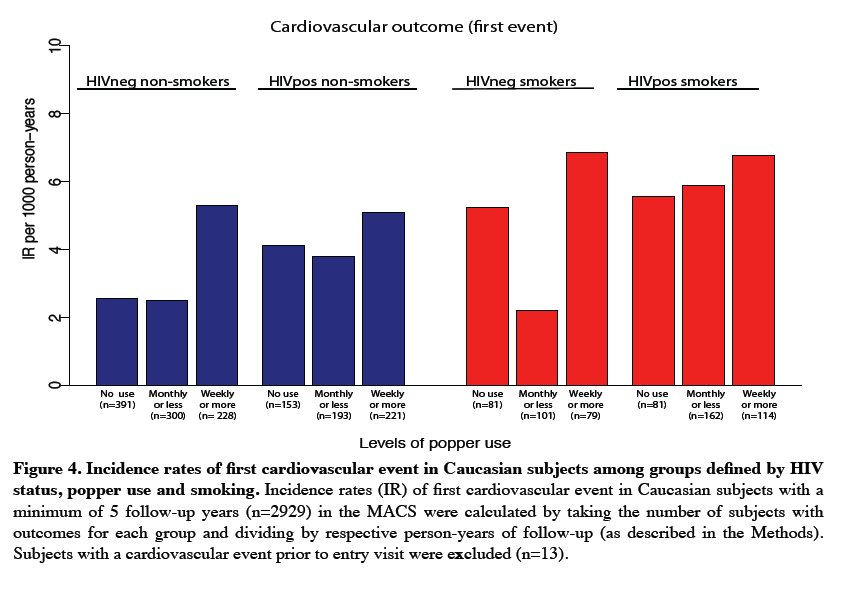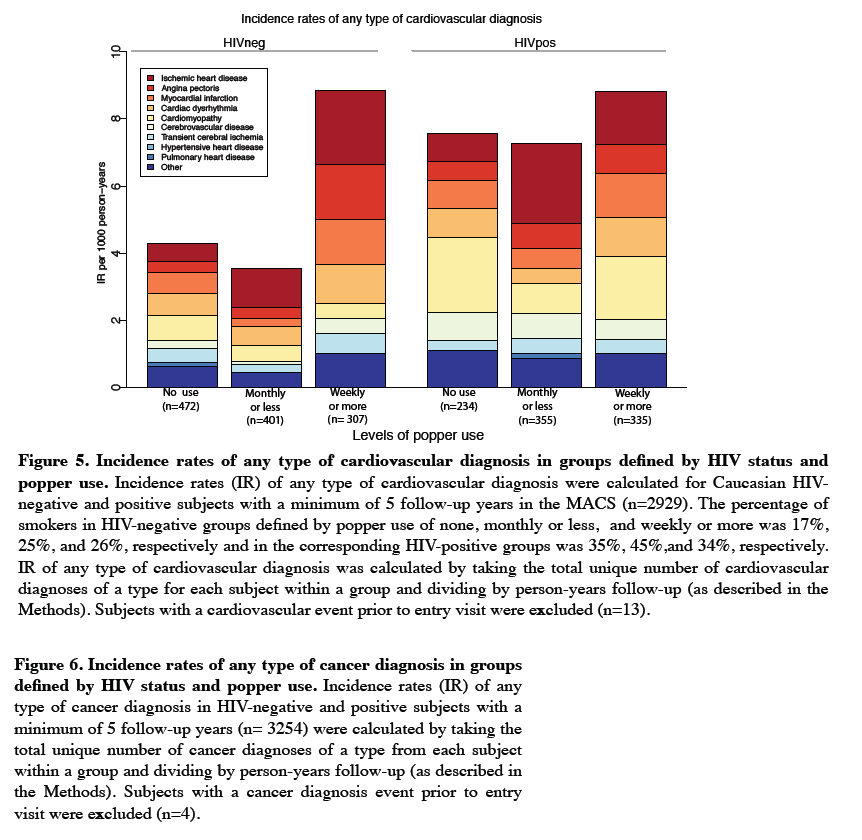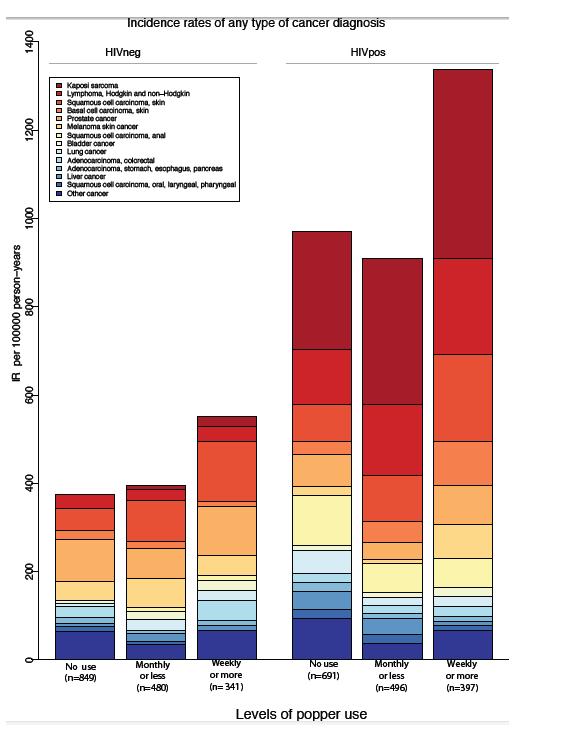 |
 |
 |
| |
Heavy Popper Use in Gay MACS Cohort Linked to New Heart Disease, Cancer
|
| |
| |
CROI 2014, March 3-6, 2014, Boston
Mark Mascolini
Heavy long-term use of inhaled nitrites (poppers) was linked to new cardiovascular disease and cancer in HIV-positive and negative gay/bisexual men in the US Multicenter AIDS Cohort Study (MACS) [1]. More than half of men in this prospective cohort used poppers.
HIV-positive people in the United States and elsewhere often use recreational drugs linked to faster HIV disease progression and non-AIDS conditions. Because long-term effects of these drugs on comorbidities remain poorly characterized, Dana Gabuzda and colleagues at Boston's Dana-Farber Cancer Institute conducted this analysis of HIV-positive and negative men enrolled in MACS.
For 3366 HIV-positive and negative men making twice-yearly visits from 1984 through 2007 (and with at least one visit after 1995), the researchers checked MACS records to create individual trajectories of drug use defined by maximum use reported at two or more study visits. They looked specifically at use of nitrite inhalants (poppers), cocaine, MDMA/MDA, uppers, marijuana, and heroin/opiates. Among men with a minimum 5 years of follow-up and stratified by HIV status, race, popper use, and smoking status, the researchers calculated incidence (new diagnoses) of any cardiovascular outcome, including ischemic heart disease, angina, myocardial infarction, and cardiac dysrhythmias. They used similar methods to assess the impact of popper use on cancer incidence.
More than half of these men (53%) reported using poppers in the past 6 months, a higher proportion than used marijuana (44%), cocaine (20%), uppers (10%), or MDMA/MDA (7%). Among 1670 HIV-negative men, 1589 HIV-positive men, and 107 men who became infected during follow-up, median baseline ages were 34, 33, and 27, and median numbers of study visits were 27, 18, and 21. Most men in the negative, positive, and seroconverter subgroups were white (74%, 61%, and 74%), and substantial minorities smoked (32%, 46%, and 48%).
The cardiovascular risk analysis involved 919 HIV-negative nonsmokers, 567 HIV-positive nonsmokers, 261 HIV-negative smokers, and 357 HIV-positive smokers--all of them white and with at least 5 years of follow-up, and none of them with a cardiovascular diagnosis before follow-up began. The researchers further divided those groups into men who used poppers at least weekly (heavy users), those who used them monthly or less often (occasional users), and nonusers.
Among HIV-negative nonsmokers, cardiovascular disease incidence approached 6 per 1000 person-years in heavy popper users, compared with just over 2 per 1000 person-years in occasional users or nonusers (Figure 4 in attached poster). Cardiovascular disease incidence stood at about 5 per 1000 person-years in HIV-positive nonsmokers who used poppers heavily, compared with about 4 per 1000 person-years in occasional users and nonusers. Incidence of cardiovascular disease was also higher in heavy popper users than occasional users or nonusers among HIV-negative smokers and HIV-positive smokers.
The analysis of cancer incidence involved 1670 HIV-negative men and 1584 HIV-positive men with at least 5 years of follow-up, again divided into heavy popper users, occasional users, and nonusers. None of these men had a cancer diagnosis before follow-up began. Among HIV-negative men, cancer incidence approached 600 per 100,000 person-years in heavy users, compared with about 400 per 100,000 person-years in nonusers and occasional users (Figure 6 in attached poster). Among HIV-positive men, cancer incidence lay at about 1300 per 100,000 person-years in heavy popper users, compared with 900 to 1000 per 100,000 person-years in occasional users and nonusers. HIV-negative and positive heavy popper users had a 2-fold higher incidence of squamous cell skin carcinoma than occasional users or nonusers.
The researchers concluded that white, HIV-negative, nonsmokers who used poppers heavily had more than a 2-fold higher cardiovascular disease incidence than those who used poppers occasionally or not at all. Weaker associations between heavy popper use and incident cardiovascular disease could also be detected in white HIV-negative smokers and white HIV-positive smokers and nonsmokers. In an email message to NATAP, Dana Gabuzda stressed her concern that "there is not enough awareness of these and other adverse health effects of nitrite inhalants in the community."
Reference
1. Holman A, Dutta A, Gabuzda D. Long-term effects of nitrite inhalants on cardiovascular and renal outcomes in the MACS cohort. CROI 2014. Conference on Retroviruses and Opportunistic Infections. March 3-6, 2014. Boston. Abstract 740.
---------------------------------
Long-term Effects of Nitrite Inhalants on Cardiovascular, Renal, and Cancer Outcomes in the MACS Cohort
Reported by Jules Levin CROI 2014
Alex Holman1*, Anupriya Dutta1,2, and Dana Gabuzda1,2,
1Dana-Farber Cancer Institute and 2Harvard Medical School, Boston, MA










|
| |
|
 |
 |
|
|